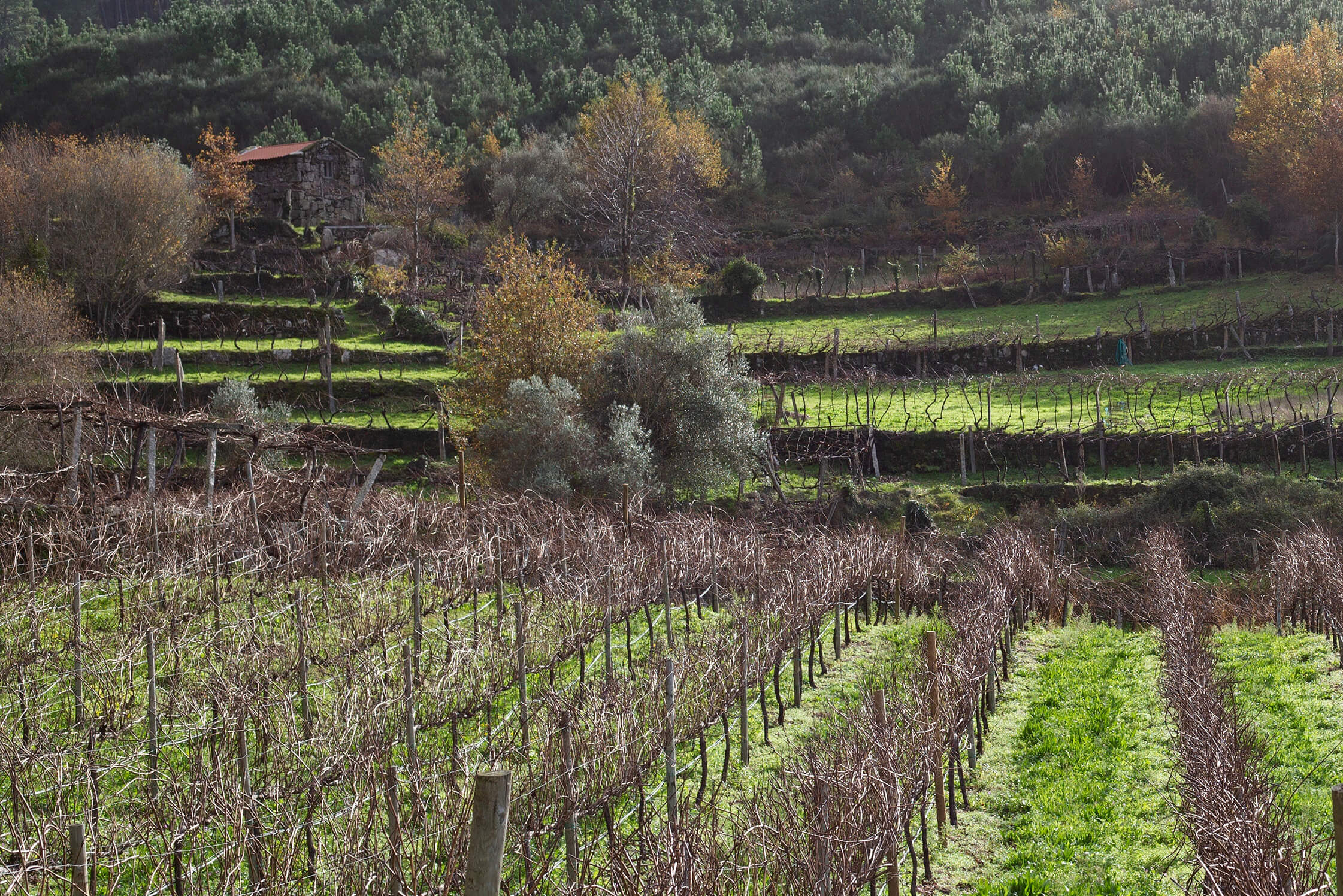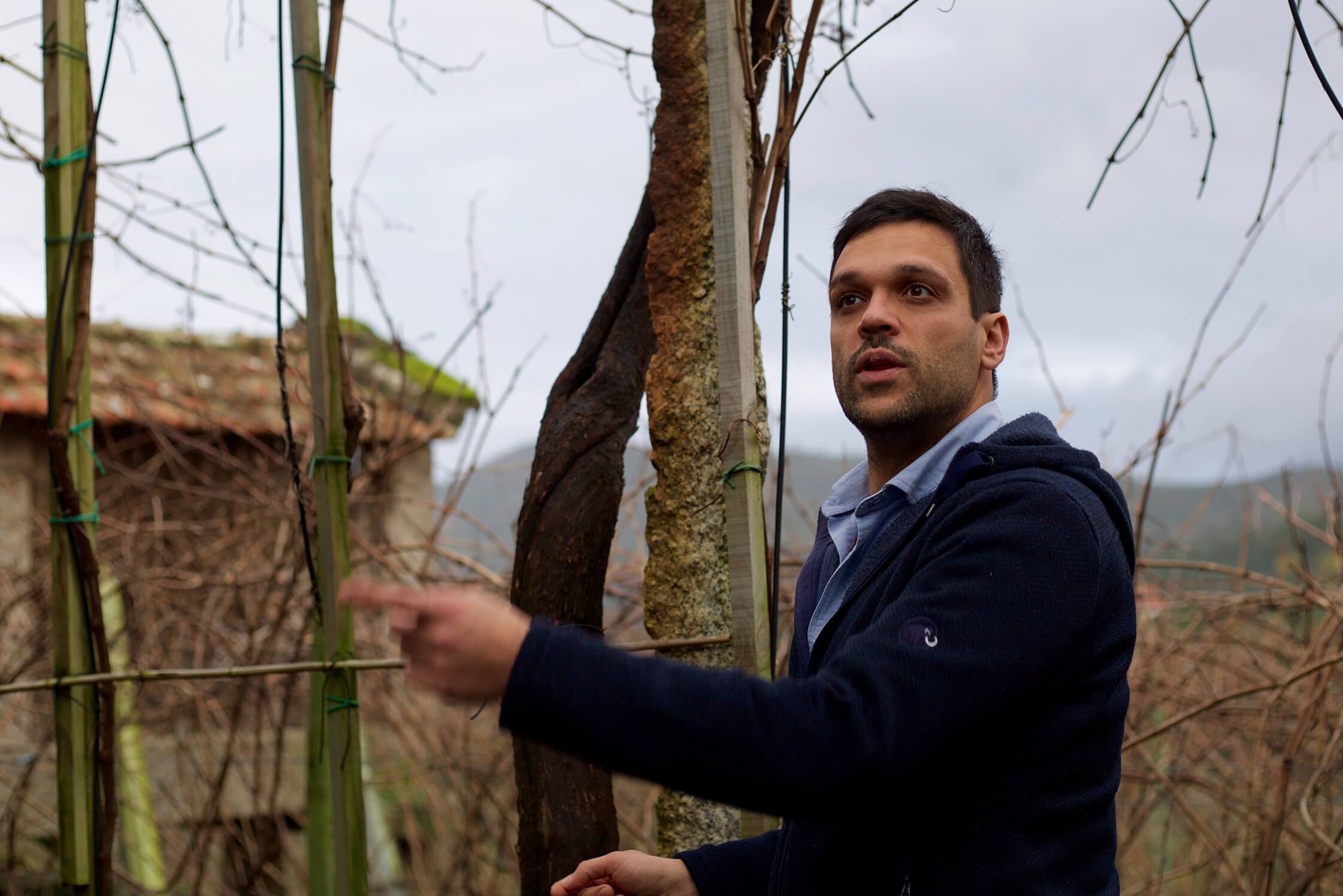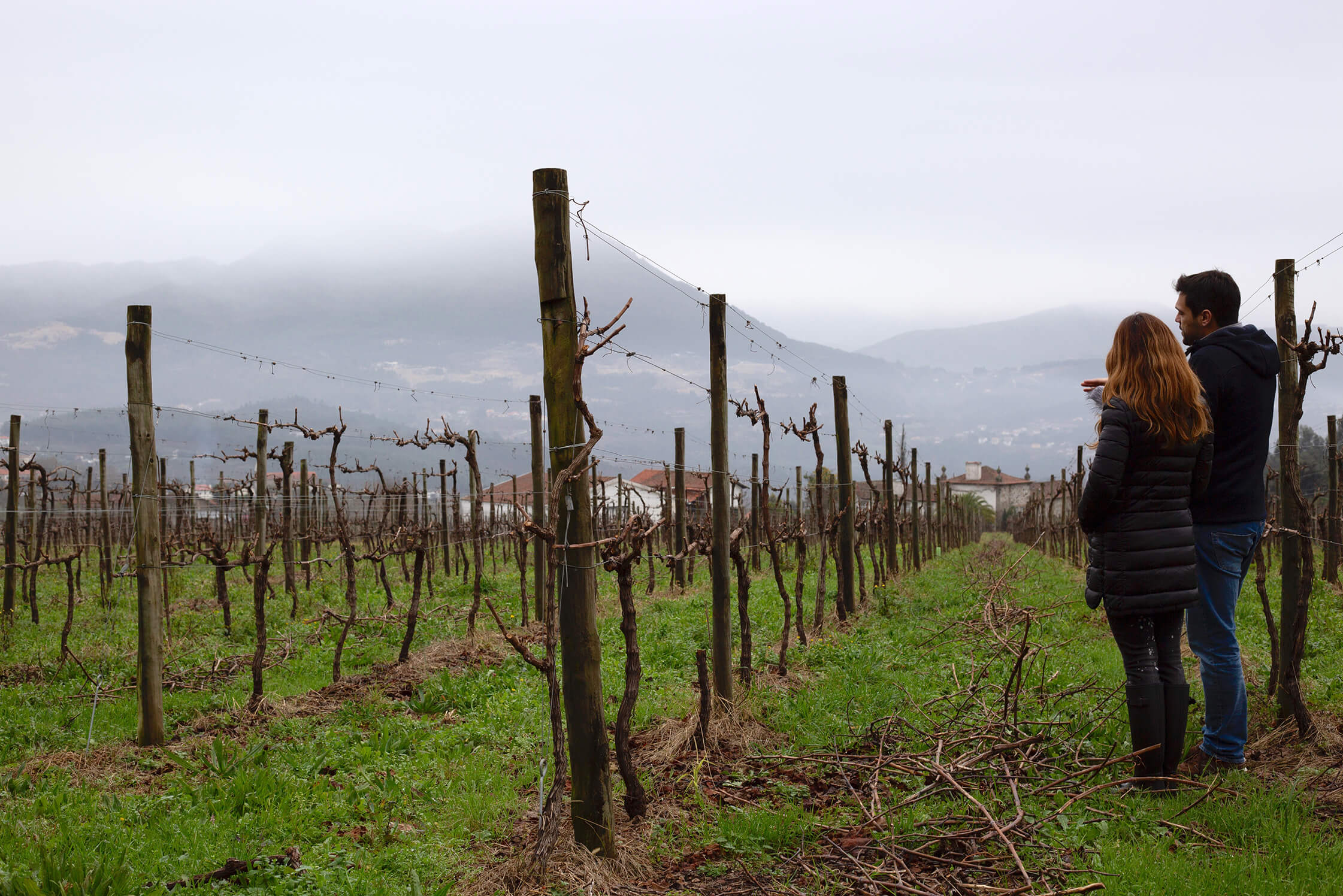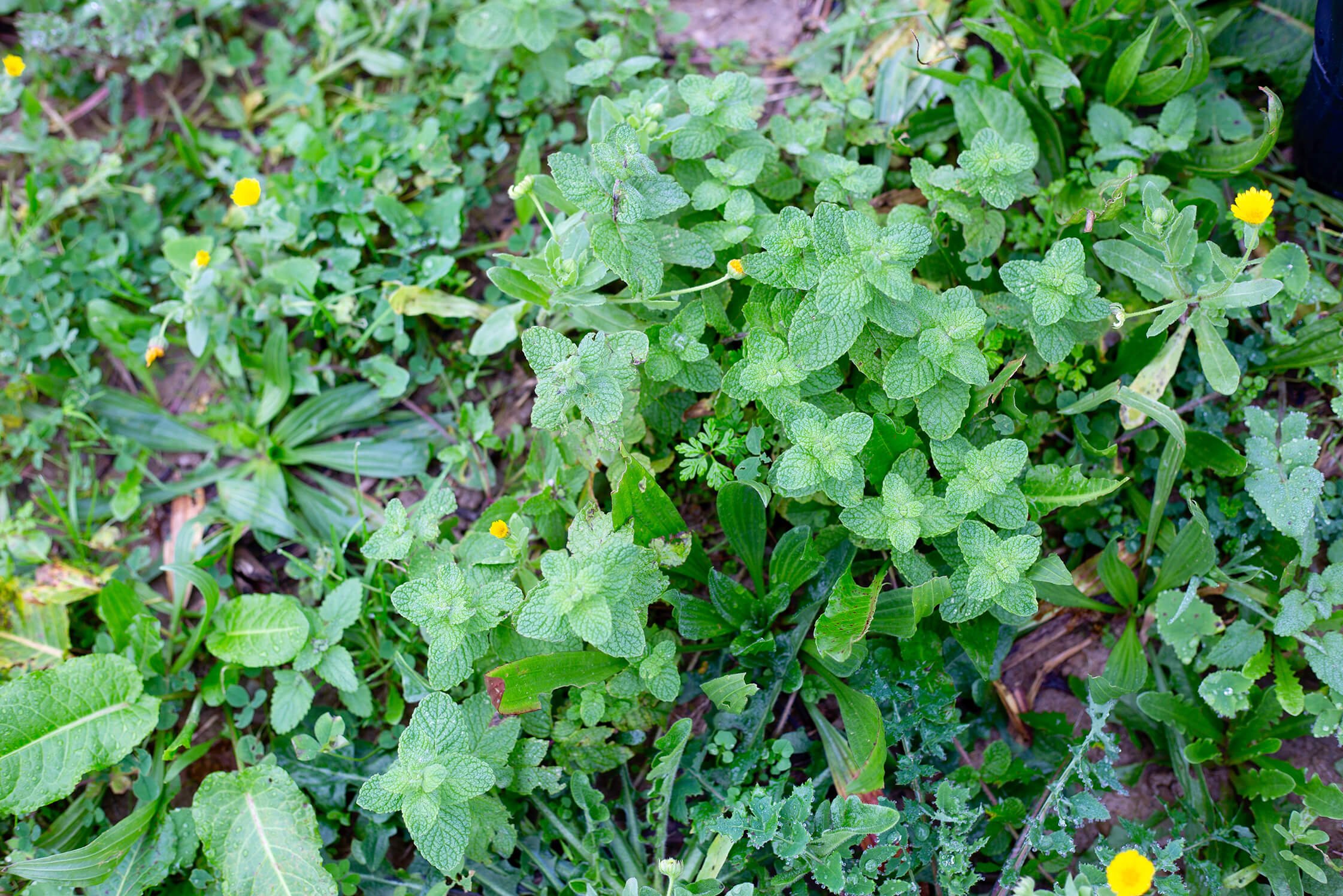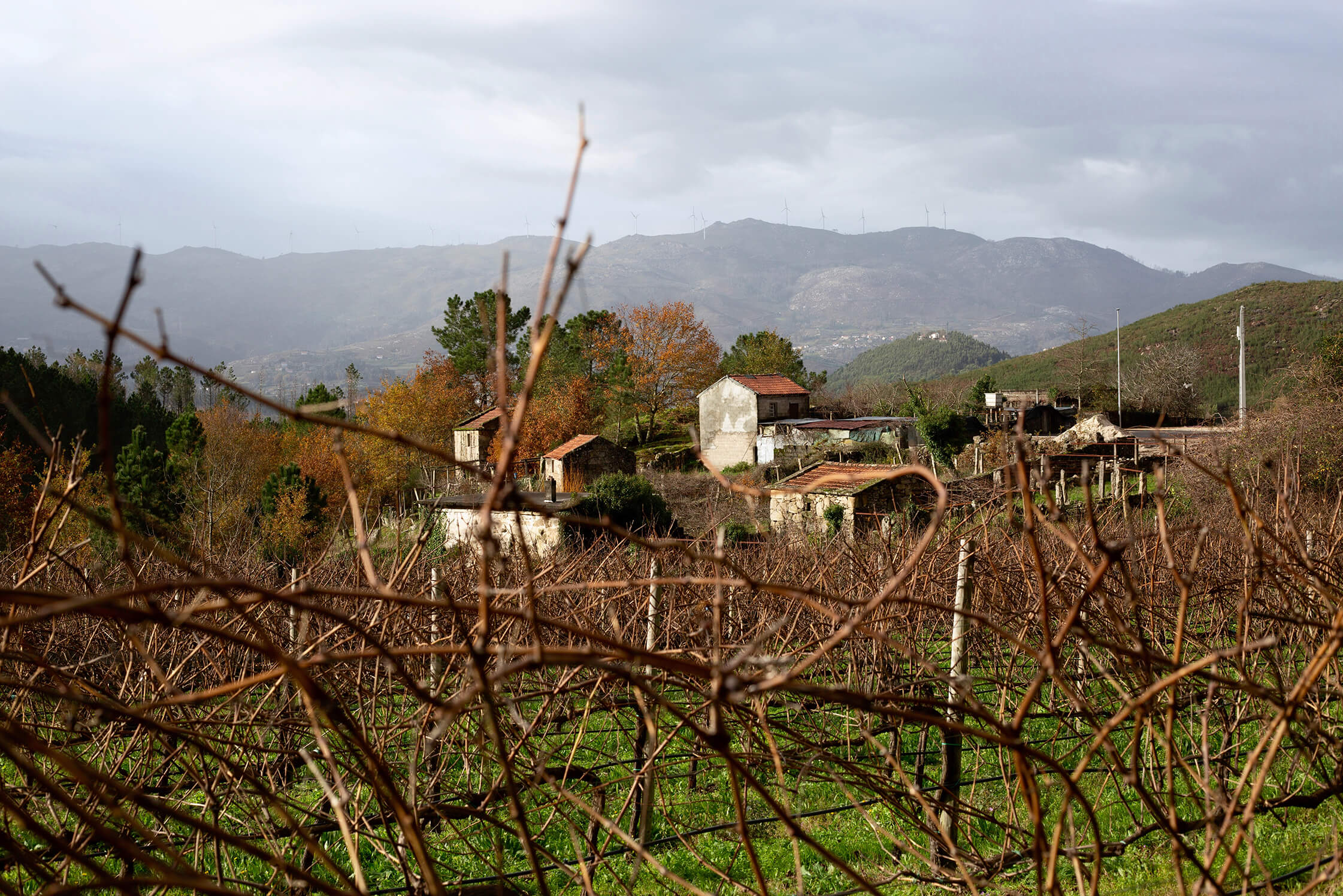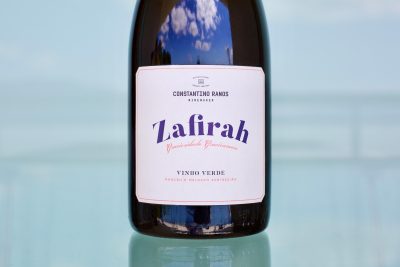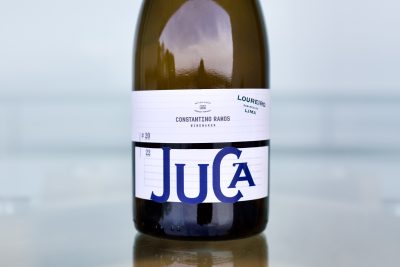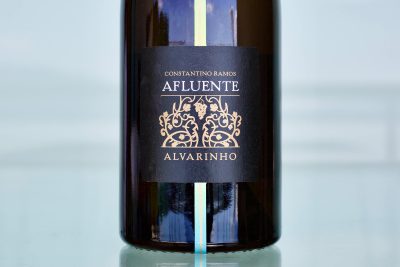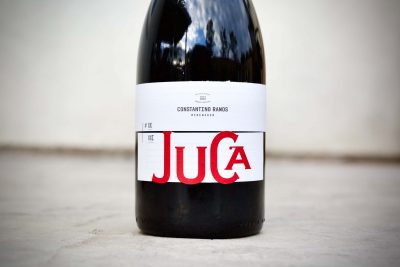Constantino Ramos
Short Summary
Full Length Story
Constantino Ramos is the most interesting young wine producer in Monção e Melgaço, Portugal’s most prestigious and famous subzone of the Vinho Verde. Once mentioned in conversation with other Portuguese winemakers and wine professionals, all familiar with Constantino and his wines express their belief in his talent. Fortunately for us, we nabbed him early on and what we’ve experienced thus far is extremely promising.
It All Started…
At a beach pub outside of Lisbon, Constantino Ramos felt the need to come clean with the woman he hoped would someday be his wife. The confession? He hated his job. Pharmaceuticals was a bore and thoughts about someday making wine like he did with his grandma when he was a child in their vineyards in the Dão had started to overwhelm him. Margarida’s immediate support gave him the push he needed and he penned his resignation letter that night.
When Constantino was growing up, wine was a large part of his family’s daily meal and the reason for their annual harvest of grapes. He was always interested in the subject, but his family never made it on a commercial level. Relatively young (born in 1983), he’s a hobby historian, encyclopedic with information about Portuguese politics and wine culture and old Portuguese wines in general. So when you hear him speak about the world it feels that he’s coming from the vantage point of someone twice as old. His perspective on wine is also broad because, like many who have reached the highest level in our industry, he’s well traveled outside of his home country. Only twenty minutes away from where I live in the Vinho Verde, we spend a lot of time together and he’s always full of pleasant surprises and is impossible to top when it comes to generosity. And while I’m a little older, he feels like our big Portuguese brother or uncle; I think all who know him feel that way, no matter how much older they are. He’s truly an old soul, if there is such a thing.
After attending university for six years to get his pharmaceutical degree from the University of Coimbra, he worked in Lisboa (Lisbon) for four years in the business and met Margarida, a microbiologist who was also in the pharmaceutical industry. The second step for Constantino after resigning was to go back to school but in Vila Real, where he would earn his master’s degree in enology and viticulture. He told me that the transition was easy because of his prior education and practice involving many of the sciences required by enology school that were, as it turned out, useful when it comes to making stable wine.
During the last year of enology school, Constantino began to work for a small Dão winery named Quinta dos Roques. From there he went to work in the Douro for Alves de Sousa where he met the man visiting the estate who would become the greatest mentor of his wine career and long-time employer where he still works today, Anselmo Mendes. The opportunity to go to the Vinho Verde was ideal. He would learn from one of the most progressive and talented winegrowers in Portugal, while being close to his wife’s family who lived along the Minho River, less than an hour from his work and thirty minutes from where they would eventually settle in Viana do Castelo.
Discovering Senhor Alvarinho
Senhor Alvarinho, as they commonly refer to Anselmo Mendes, is the modern day godfather of the Vinho Verde, and more appropriately its most globally successful subzone, Monção e Melgaço. Yet there were pioneers before him that made it easier for Anselmo to take the region to the next level. Amândio Galhano first blazed the trail for Alvarinho (known in Spain as Albariño) and understood how important it would be for the potential success of Monção, and ultimately Melgaço. Galhano went to other countries to learn how they worked and experimented with rootstocks that would be more suitable for this subregion’s granitic soils. He worked with the famous Palácio da Brejoeira, who made quite extraordinary Alvarinhos at the time. Galhano died in the beginning of 1990s, but Mendes and another well-known and progressive producer, Soalheiro, who Constantino says made quite special wines in the 1980s and 1990s under the man who started the quinta in 1982, João António Cerdeira, carried on his legacy of progress. As stated on their website, Soalheiro pioneered Alvarinho in Melgaço in 1974. For around ten years during the 1980s and 1990s there were about fifteen producers, and today there are still fewer than fifty small commercial winegrowers within the Monção and Melgaço subzone.
I’m not sure anyone inside or outside of Monção and Melgaço would dispute the idea that Anselmo Mendes has simply set the bar for what can be achieved with Alvarinho in Portugal today. The entire region has something to glean from his drive and experimentation to push Alvarinho to the next level. And like any luminary, enlightenment didn’t happen overnight, but Mendes seemed to be a natural from the start.
Anselmo was born and raised in Monção. And like Constantino, he had a degree in another field, but redirected toward wine and later went to enology school in Montpellier, France. In his early years, he went to work for Borges, a large company with a lot of vineyard land in the northern half of Portugal. There he learned different perspectives that would further open his mind to new possibilities and ways of winegrowing. In 1998, Anselmo launched his own project and eventually left Borges some years later. This is where Anselmo began to put his ideas to the test with different techniques such as skin contact and oak treatments on Alvarinho—radical, right? But he was the first to seriously do these things. Ultimately he was able to earn a living making wine (a rarity at the time) and also developed relationships as a consultant for many producers along the way.
So, why all this talk about Anselmo Mendes when this is Constantino’s story? Well, as they say, people are products of their environment. Constantino is the head winemaker at Anselmo’s winery, and Anselmo has inspired many of the ideas behind Constantino’s work on his own project. I’ve not met Anselmo, but I know by his story and influence on the Portuguese wine world and Constantino that they are cut from the same cloth, where insatiable curiosity meets passion, intelligence, motivation, and vision. Constantino is just getting started and after only a few vintages (2016 was his first), the writing on the wall seems to say that he will also be known globally for his exemplary work in the Vinho Verde.
The Wines: Zafirah and Affluente
Constantino’s personal wine project started with a challenge from his cousin, Xavier, from Margarida’s side of the family, who had a few small vineyard plots in Monção that were higher in altitude than the typical vineyards in the area. In 2017, Constantino produced an Alvarinho that he calls Afluente (in reference to a stream passing by; not because it’s made for affluent people, or because it’s expensive; it’s not.), and the red, Zafirah (a Muslim name that means graciousness), made of a mix of the high-spirited red grapes, Brancelho (also commonly known as Alvarelhão in Portugal, and Brancellao or Albarello in Spain, and seemingly dozens of other names), Cainho Longo, Espadeiro, the dark and structured Vinhão (also known as Sousão in Portugal and Sousón, in Spain) as well as a high acid red called Borraçal (Caíño Tinto).
The Alvarinho is made very closely in style to what Constantino does at Mendes’ cellar—perfectly sensible given the success of the experiments he and Mendes do together from vineyards similarly situated as the one used for Constantino’s wine. In short, the Alvarinho was planted in 2014 at around 200 meters altitude on granite bedrock and topsoil—a ubiquitous bedrock and topsoil type within Monçao and Melgaço. The grapes are picked much earlier in the growing season than almost all those surrounding them because of Constantino’s preference for extremely fresh white wines. Destemmed before pressing and settled for two days, the wine is then put into 400-liter old barrels for its natural fermentation that lasts around four to five days and doesn’t exceed 23°C, a temperature that encourages a little less of a fruit profile and promotes more savory nuances. (Lower temperatures can intensify the primary fruit characteristics of any wine.) Continued aging occurs in the same barrels on the gross lees for nine to ten months, and Constantino maintains that the gross lees of Alvarinho in this area are usually clean and rich, and rarely give off off-odors, or negative reductive aromas. He employs battonage three or four times in total, depending on the acidity level of the vintage—more in cooler years, less in warmer years. The overall style of the wine is high-toned, with citrus and strong savory components and a medium-to-broad mouthfeel.
When given the rundown on winemaking for the red, I admit I was surprised and had to ask numerous times to confirm that what I thought I heard was correct. The red is made like a short-term, skin-contacted white, or long skin-contacted rosé. After destemming, the grapes macerate on the skins for only two days and are then pressed, tank settled for an additional two days and then put in 225-liter old oak barrels (15-20 years old) for fermentation. The fermentation is natural and there is no temperature control; however, the size of the barrels limit the temperature to a maximum of around 23°C. The wine is lightly filtered to clarify any turbidity, and there are no fining agents used before bottling. The sulfite level of the wine is low, thanks to the naturally high acid and low pH of the wine. The average age of the vines is thought to be well over fifty years, but not exactly known—typical in these parts. (More information about each vineyard site is outlined further into this text.)
In the vineyards, no herbicides or pesticides are used, and the management of the grasses and herbs are done by hand with weed whackers. However, given the high humidity of the region, it is typical in all winegrowing cultures, whether sustainable, organic or biodynamic, that a lot of work be done to manage mildew that if left unchecked for a moment can severely damage the crop.
More Portuguese Wine Backstory
A drive through the Vinho Verde, and Portugal for that matter, reveals Portugal’s deeply ingrained vinous history. There are grapevines everywhere, but strangely few quintas—or wineries. And throughout the countryside are countless farmhouses with vineyards trellised high above the ground, wrapped around a field that is filled with other crops. So many of them make their own wines; even the woman who comes to help us clean our apartment here and there grows most of her own vegetables, chickens and makes her own wine too, a rustic (and not-so-bad) red wine made of Vinhão and Loureiro Tinto, two of the more structured grapes around that are vinified for a short time on their skins (and oftentimes on the stems because home growers don’t have the money for destemming equipment) so as not to extract so much in the way of built-in tannins; I’ve tasted nearly black Vinhão that was fermented on its skin for less than a day and they still exhibited a serious level of tannins. Portugal is really just starting to find solid footing from a grower/producer standpoint.
Dictatorship and the Wine Cooperativas
It’s not a common occurrence elsewhere in the wine world, but when one digs into the history of Portuguese wines from before the 1990s, many of them were made and sold by cooperatives, or, co-ops. To my surprise, I’ve had many wines made by co-ops in the 1960s and up until the 1980s that were shockingly good as well as cheap and still available.
The movement of the cooperatives appeared in Portugal around the 1940s when António de Oliveira Salazar, Portugal’s second-to-last dictator, who ruled from 1932 until 1968, “obliged” growers to sell most of their crops to the co-ops. He also decided that the Alentejo wine country be dedicated to the production of other crops and it was converted into a sort of “bread basket” for Portugal. It was only after the peaceful transfer from dictatorship to a democracy (four years after Salazar died) in the bloodless Carnation Revolution, known in Portuguese as Revolução dos Cravos, that this changed. In April of 1974, without a single political gunshot fired, the transfer of power was made, perhaps setting the tone for the Portuguese gentleness that my wife and I, as foreigners living in Portugal, feel everywhere from the people at the bank to the grocery store clerks. In the 1980s, Alentejo began to redevelop widespread production of grapes, which rapidly continued to become the powerhouse it is today. The Alentejo covers about a third of Portugal’s continental landmass and has a vineyard area similar in size to the Vinho Verde of around 21,000 hectares (about 52,000 acres). It should be noted that the Alentejo had a history of exceptional wine production before phylloxera kicked off a series of events that ended with Salazar’s decision to reshape its production from wine to grain; wine had been well-documented in Alentejo long before the Romans arrived.
The co-ops were focused on quantity, not quality, and wines bottled in 750 milliliter bottles, like the vast majority of commercial wines today, were rare—most were sold in five-liter jugs. The exchange between the growers and the co-ops was simple: bring the grapes and we send you home later with some wine. In the 1980s the co-ops began to crumble because of poor management and decreasing interest from the growers after the dictatorship fell, so most of them went bankrupt or into very difficult periods. This started to force grape growers to become winegrowers, and small wineries began to spring up all over Portugal, with some of them becoming the strong and most recognizable brands in the country today. Interestingly, during the dictatorial years wine took on a stigma, especially with women drinkers, who were thought to be rude, to exhibit poor behavior or to be connected to seedy environments. Typical age-old chauvinism.
Cooperativas Today
Constantino explained that there are still quite a few really good co-ops in business; he estimates around seven or eight. In the Vinho Verde, the co-op, Adega de Monção may be the highest quality, and others still in the Vinho Verde, like Adega Ponte de Lima (in my new hometown!) and Adega Ponte de Barca make very good quality wine for their price.
I, for one, am impressed by the quality of the wines produced by these cooperatives. It’s not what’s on my table at home, but on occasion when we go out we have to make a choice on very limited wine lists because most restaurants in the countryside don’t have deep and interesting lists; they just have local wines and the decision is always a leap of faith. My personal advice is to stick with the cheaper whites because they go with all sorts of food, including meats, and they are probably not obliterated by poor stylistic choices in the winemaking. Or, try the basic red Vinho Verde wines. I am a big fan of the cold, sparkly and deliciously rustic Vinhão, served in white porcelain bowls; however, Vinhão is not for everyone…
The quality of the inexpensive wines made by cooperatives makes sense on many levels, especially when you see most of the small homegrown vineyards scattered throughout the landscape without an adjoining winery. Those who deliver their grapes to the co-ops often treat their vines as they do other crops in their gardens. The Portuguese people are especially skilled in growing things (probably as much as anyone in all of Europe) and they really tend to each vine on a individual level, not in a massive mechanical and chemical way—they live in these places and the smart ones don’t want their kids to get into the chemically dosed earth while they’re playing in the area, nor do they want to eat food from such toxic origins. Their grape vines surround their crops like a fence, so all the growing things live in the same environs. This is part of the reason why in the north of Portugal the average co-op wine can be surprisingly good. Another contributing factor is that the grapes they grow are naturally high in acidity and result in more stable wines, even if the winemaking processes are not at times state of the art. In the world of cheap wine with an authentic personality expressive of its place, it’s difficult to beat the Portuguese.
In the 1980s things began to change from this rustic model. Not only because of the start of collapse of the cooperatives, but also due to the technical advances that paved the way for small growers to turn what was only a portion of income into a viable and regular primary enterprise. Late in the 1990s and early 2000s, with the help of the EU and Portuguese government, the export market for the wines began to grow in places like the UK, US, Scandinavia, and Brazil. Exporting wines is obviously much more profitable than focusing solely on the Portuguese domestic market. The Portuguese indeed love their wine, and are the largest consumers of alcohol on mainland Europe, but they don’t have much of a budget for wine, so they rely on what they make themselves or what they can get in exchange for their grapes with their local co-op; the rest usually buy the cheapest wines on the shelf because quantity is more important than quality for those who make the 740€ per month wage (2020). And in the Vinho Verde, the quality of the cheapest wines, especially the whites, is extraordinarily high.
Great Portuguese Food, Bad Wine Lists. Help Below…
Most of the best food in Portugal is served up in typical Portuguese restaurants with uninspiring wine lists. We’ve often looked in dismay at the options and wish that we had a knowledgeable friend to guide us away from disappointment toward something palatable and possibly even good… So, here’s a few good cooperatives according to Constantino, other than those already mentioned from the Vinho Verde (Adegas Ponte de Lima, Ponte de Barca and Monção e Melgaço): the Douro’s Adega Vila Real, Bairrada’s Adega Cantanhede, and Alentejo’s Adega Borba. Many producers on the list outside of co-ops don’t have such a soft touch in their winemaking and have done distasteful things, at least for my taste. The most common offense is excessive oak, or bad new oak, especially with the country’s expensive big brand wines. In a typical restaurant, I find it better to stick to a simple co-op wine and focus on the food.
If it weren’t for the severe dearth of conscious and progressive producers with more global context for the fine wine world, the Vinho Verde could be one of the most obvious picks for near future explosive expansion, like the direction Galicia is headed today. But the shortage of talent and resources is glaring. That would make it easy for me to do a layup on this one by giving a brief summary of only the wines we import from Constantino, but I don’t want to do that. It’s my home region now, yet after seeing so much of the rest of the wine world, I clearly see its enormous potential here, as relatively untouched by just a few inspired people as it is. Part of the problem is that there isn’t enough written about it… So, let’s dig in a little on the Vinho Verde (pronounced with a hard “d” and an almost complete silent draw on the last “e”) and more specifically, Monção e Melgaço.
Professor Amorim Girão, a geography teacher in Coimbra, home to the most famous university in Portugal, aptly described Vinho Verde as “a vast amphitheater, which starting at the coast, gradually climbs in elevation toward the interior.” This is accurate for the most part, and where the amphitheater begins to crest, the DOC (Denominação de Origem Controlada) wine region, Tràs-os-Montes, begins in its north and eastern flank—literally translated as “behind the mountains”—with part of the Douro toward the east/southeast, and the Dão further south of the Douro.
The Climate
Perhaps easier to understand, the Vinho Verde subzone, Monção e Melgaço, is on the edge of the appellation in the northern-most section of Portugal, outside of that amphitheater-like topographical relief Girão spoke of—as is the next subzone to the south, the Lima Valley. To the north of Monção e Melgaço is the meandering Minho River, a natural border between Portugal and Spain for about a fifty-mile stretch. The river valley has a strong influence on this single subzone of nine within the DOC. It should be noted that the subzones are a new feature in the Vinho Verde since the 2000s. In the past it was mostly just focused around Monção e Melgaço and the Lima Valley.
In the Minho River valley and the small valleys that open up into it inside Monção e Melgaço, the climate is a confluence of continental and oceanic conditions, but despite starting only thirty kilometers by air to the east from the ocean, it is usually classified as a Mediterranean/continental climate. This classification may partly be because there are extremes in temperatures that peak in the summer around 42°C (108°F) and drop down to below freezing in the winter months—figures that took me by surprise given its close proximity to the Atlantic. The diurnal summertime shift here can be as much as 20°C (almost 40°F) between day and night. This was also unexpected because it is just about forty kilometers to the north as the crow flies from where I live in the Lima Valley, where the diurnal shift in the summertime isn’t nearly as dramatic, and the winter temperatures rarely drop below 8°C (45/46°F). The Lima Valley is quite the opposite and is classified as an oceanic climate, like Spain’s Rías Baixas subzones, Val do Salnés and O Rosal. It is also hillier in the Lima Valley and less mountainous, especially toward the south and west. However, because the Minho River runs east-to-west, the Atlantic has its influence in Monção e Melgaço, and the precipitation mostly comes from the west.
Precipitation in Monção e Melgaço is pretty high, at about 1200mm (around 47 inches) annually. Thankfully, the bedrock and topsoil is almost exclusively granite. This helps greatly with drainage because the coarser soil grains that remain in place are derived from the granite bedrock below.
Principal White Grapes of Monção e Melgaço
Most who know Alvarinho know its strong citrus character, high acidity, medium alcohol level, and deep, noble qualities, especially with a few years of bottle aging. The best examples can compete with some of the great white wines of the world, and the worst examples are rarely offensive. One could say that Alvarinho (Albariño, in Spanish) could be Iberia’s equivalent of France’s Sancerre due to its universal appeal, versatility and upfront appearance of simplicity. The only thing in Portugal that might hold it back from an English-speaking perspective is the spelling and pronunciation of its name compared how they write and say it in Spain, which is somehow easier to say because there is no context for the Portuguese language in the US culture, and Spanish Albariño was also established earlier in the US market first.
Interestingly, Alvarinho wasn’t always a fixture of Vinho Verde, and its most suitable area, Monção e Melgaço. It might even come as a surprise that it arrived at the end of the nineteenth century and only first appeared on a label of Vinho Verde from Monção in 1920. It slowly became the most important grape variety in the area, by far. In fact, until the mid-1990s, the Vinho Verde produced more red wine than white. Now it’s dominated by white wine production. From a commercial standpoint, still white wines are more profitable due to the faster turn around. Alvarinho also commands the highest prices at the Portuguese co-ops and in the open grape market.
Some Other White Grapes of Vinho Verde
Perhaps the second most successful single-varietal wine bottled on its own in Vinho Verde after Alvarinho is Loureiro. This grape perhaps thrives best in the Lima Valley. Grown in this Atlantic climate it creates high acid, low alcohol, minerally, and citrus-strong wines. It’s an extremely productive vine, so for anyone looking to achieve elevated quality, the vines need a great deal of work. Quinta do Ameal, a producer we work with in the Lima Valley, shows clear proof of the merits of this grape’s ability and potential. Many of the wines of Ameal age effortlessly—even the entry-level Loureiro—and seem almost unchanged after ten years in bottle. However, as it ages, similarly to Alvarinho, it develops aged Riesling-like petrol notes. And the wine is usually very inexpensive and can outlast many great white wines of the world that pack a punch in their youth but are either overworked or not worked enough and fizzle out well beyond their time. At least the risk with a good Loureiro isn’t so taxing on the pocketbook.
Trajadura, known in Galicia as Treixadura (with the “x” pronounced –sh), can also be an interesting grape on its own, but must be harvested at the perfect time to retain its natural acidity and maximum complexity. It’s usually blended into other wines, such as the Piras grape, which can be useful to many blends because it generates high yields with good resistance to vine diseases. Piras is also low in acidity and used to soften wines with the Vinho Verde’s dominance of big acid grapes. Azal produces a somewhat neutral white wine with sharp malic acidity and in most subregions it’s difficult to ripen properly, but thrives in Basto, another of Vinho Verde’s subregions. It’s usually harvested three to four weeks after Alvarinho. The ubiquitous Arinto is an easily adaptable grape to many different environments. The Portuguese commonly say, “Arinto is the muscle and acidity for all the blended wines in Portugal.” It has good yields and is easy to work. In Vinho Verde it’s known as Pedernã and is the second-most planted variety in Portugal after Fernão Piras.
Red Grapes of Monção e Melgaço
Monção e Melgaço was historically red wine country, and the arrival of phylloxera to Europe became a temporary boon for the red grape export market, especially the black, rustic and structured Vinhão grapes, which were sold to Bordeaux during the crisis. The same was the case with so many other sturdy red wines of Europe, perhaps most famously those of France’s Northern Rhône Valley Syrah—to blend with other grapes as an enhancer of structure and color. Once phylloxera (the famous root louse that eats the roots of vitis vinifera species of grapes—those that make the best wine) became manageable with the discovery that sturdier American rootstocks could be used in place of those from vitis vinifera, which resulted in things normalizing. Vinhão remained favorable to Portuguese winegrowers because it was so strong by nature; they could add water and still have what seemed like a good wine. Eventually commercial interest in Vinhão waned due to the ascendant value of Alvarinho grapes, and its rustic, hardcore red wines were not for everyone. It’s now a pretty obscure grape known to be mostly made by the locals for home consumption, a sad fate for a grape variety that exhibits true potential but is simply in need of courageous wine professionals to tame it and expose the quality of its underbelly. I believe in this grape because I’ve had many versions of it that were so impressive despite the rustic, intense character. It’s like Syrah on steroids, but with a massive dose of acidity.
There are other red grapes that have hung on for dear life in Monção e Melgaço, but are usually tucked up into the hills and mostly grown by home winemakers. These obscure grapes are the focus of Constantino’s red wines. (He laughs at me when I speak of my belief in and love for Vinhão!)
Brancelho (also known in Portugal as Alveralhão, and Spain as Brancellao, or Albarello) is a rarity with only about ten hectares of vines in Monção e Melgaço, most of which are owned by older people. It also grows in a few spots in Portugal’s Dão and Douro wine regions and is one of the most interesting prospects in northwestern Iberia. On its own (which is more common in Galicia), it can produce light-colored wine with intricate aromas, good freshness, and a light to somewhat medium body.
The other red grapes of focus for Constantino are Cainho Longo (or Caíño Longo, in Spain), a fabulous grape variety known for its broad range of red and dark fruit, big acidity and medium tannins—the latter of which is completely dependent upon the season and whether it can properly ripen. As I’ve written in the past, it’s another extremely promising grape variety in northwest Iberia. Borraçal, also known as Cainho Tinto, is similar to all in the Cainho family: high tones, high acidity, good structure. However, this Cainho has a tight cluster making it more difficult with high mildew pressure—a good enough reason for it to lose favor from a commercial perspective, but not a qualitative one.
The two most common red grapes in the area are Vinhão and Espadeiro. The former, covered earlier in this essay, is the untamed beast of the Vinho Verde, while Espadeiro is quite the opposite. It’s an aromatically high-spirited variety that can bring to a blend more soft red fruit and floral tones, freshness and grace, but not lacking in structure.
Some Other Red Grapes of Vinho Verde
Padeiro de Basto, which is related to Espadeiro, has the advantage of early ripening with good potential alcohol volume. It’s often used for rosé wines. Pedral has a very short cluster and contributes higher alcohol potential but less acidity, which is helpful for balancing many of the high acid, low alcohol grapes of northwest Iberia. Loureiro Tinto, a grape not too dissimilar to Vinhão in its inky black color and big personality, although perhaps slightly less rustic? Lastly, Rabo de Anho, a light colored, very acidic red with big tannin and big acid. There are indeed more hidden treasures in the Vinho Verde, but this is a good start.
The Pergola
The vine trellising system called latada, or ramada (more commonly known as pergola), finds its utility as more of a practical subsistence farming system. Historically, grapevines weren’t planted like this, but in the eighteenth century a lot of people returned to Portugal, many from Brazil, and there was more need not only for more wine, but for a lot more food. The priority shifted to growing grains to feed the people, so the vines were trained high up and on the borders of fields to make way for crops toward the center at the ground level. And while it’s a different way than the mechanically adjusted vineyard rows found through most of the rest of the world, it is not an efficient system, nor does it generate the highest potential in quality production. The pergola is not common in Monção e Melgaço because of the dominance of the somewhat new Alvarinho that post-dated the system, when people had come to realize it wasn’t the best.
Topography and Geology
Granite pretty much makes up all the vineyard bedrock and topsoil in Monção e Melgaço, while other Vinho Verde subzones are only mostly dominated by it. However, further south and east more metamorphic rocks are present. Given this nearly singular rock presence, the important considerations become the differences of soil grain and depth, altitude variation, and exposition. Across the Minho River and into Spain, the Rías Baixas subregion, Contado de Tea, is very similar to Monção e Melgaço in topography, climate and geological setting.
The Gadanha Valley of Monção is where the first plantations of Alvarinho were made, and so was the first commercial bottle of Alvarinho, by Casa de Rodas, in 1920. Gadanha is a river valley facing north to south, with the Minho River on the north end. Here vineyards are planted on deep alluvial deposits and alluvial terraces on mostly flatter land. A hundred years ago the temperatures were notably—and understandably—colder than today, and this valley had enough warmth to ripen Alvarinho to 11.5-12% potential alcohol. Other areas in today’s Monção e Melgaço were not able to achieve this regularly, especially those at higher altitudes. Today, that is not the case. Alvarinho is grown as high as three hundred meters, but the average altitude is likely somewhere between forty to eighty meters. Those at lower altitudes and grown on these flatter, deeper terraces result in bolder, more full-flavored wines. This is due to the depth of soil and some level of clay in the vineyards.
The other two principal valleys in Monção are the Vale do Minho and Vale do Mouro. The former is similar to the Vale do Gadanha, but runs along the river Minho and has more fog, which means cooler air in the summertime, but also higher mildew pressure. The Vale do Mouro, where Constantino’s vineyards are located, was mostly carved out by a glacier and runs east to west and is some distance away from the river and out of its influence. It’s the highest altitude valley of Monção and starts around a hundred and fifty meters, and the red grape vineyards can go as high as four hundred. The locals say that this area was historically the best place for red wines, but few, aside from Constantino’s, are made commercially. Here the topsoil is more spare and the terrain marked by rocky outcrops and deep river valleys. Its wines, both red and white, are more straight, or even angular. In both topography and wine structure, they closely resemble the wines from Melgaço.
Melgaço is much more hilly and less flat than Monção. It’s also much higher ground on average. Here the climate is more continental due to the altitude and the protection of the mountains from oceanic influences and the distance from the Minho River. Through time, climate change brought more optimal conditions for growing and properly ripening grapes for commercial ventures. Climate change along with advances in viticultural practices made Melgaço’s relevance much more important. Ultimately this resulted in the subregion known in the past as only Monção to attach Melgaço to its name in 1996.
Constantino’s Vineyards
Constantino’s vineyards are mostly located in Monção’s Vale do Mouro and are, like the surrounding terrain, granitic bedrock and topsoil. There are three parcels where he harvests his multitude of red grapes, and a single plot for his Alvarinho. Vinha da Rocha is where the Alvarinho vineyard was planted in 2014 and has recently added a new plantation of Vinhão and Brancelho. Vinha de Aldeia, located in the hamlet, Riba de Mouro, is the first vineyard he worked with that made up the entirety of his first red wine in 2016. It’s the highest altitude vineyard at nearly four hundred meters and is a high density planting on a north-face. The vines are at least seventy years old and are a mix of Brancelho, Borraçal (Caíño) and Espadeiro. His Codeçal vineyard is flat and exposed to the south and planted in a traditional way with an empty field in the center. The grapes here are Vinhão, Espadeiro, Borraçal, and Brancelho. Last is a new vineyard he started in 2020 called Vinha da Raposa—which means “vine of the fox.” Not too far in a straight line from his Monção vineyards (eleven kilometers, but still thirty minutes by car), Vinha da Raposa sits at four hundred meters altitude inside Melgaço and is planted to Brancelho, Borraçal, Espadeiro, Vinhão, and Pedral. -TV


